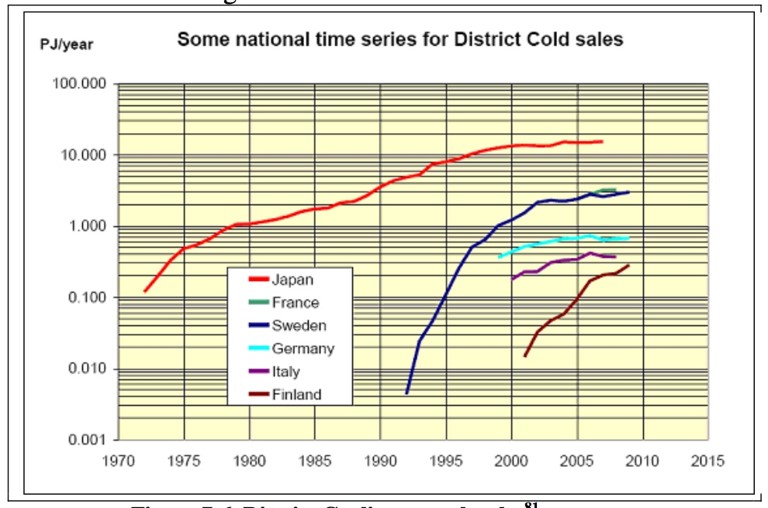WHY District Cooling ?
1. BECAUSE OF GEOGRAFICAL LOCATION

Highest ROI in Hot Climates ensuring low PP from infrastructure!!!
2. BECAUSE IT’S ECONOMICAL AND ENVIRONMENTAL BETTER SOLUTION
Since urban energy consumers typically have multiple alternatives for cooling buildings, the economic competitiveness of the DISTRICT COOLING energy option is enhanced by the ancillary benefits such as:
1. Economics of scale due to yield energy efficiency.
2. Capital savings from avoided investment in building equipment.
3. Labor and O&M savings due to simplified operating systems.
4. Lower costs for water, chemicals, insurance and fuel (including storage).
5. Higher operating efficiencies due to scale and better load matching.
6. Profits from premium buildings space savings in dense center urban location.
7. Environmental friendly by based on renewable energy, noise and CO2 emissions reduction

District Cooling System in Copenhagen:
CO2 Emissions comparisons between:
1- Centralized District Cooling System
2- Diversified local building Sorption Cooling
3- Diversified local building Electrical Chillers
1- Centralized District Cooling System
2- Diversified local building Sorption Cooling
3- Diversified local building Electrical Chillers
3. BECAUSE OF SIMPLIFIELD SYSTEMS CONTROL AND OPERATIONS

District cooling services simplify building operations by benefits such as:
1. Removing chilled water production cycle from building (no chillers, no cooling towers).
2. Chilled water distribution installation in the building remains the same (simple retrofit of building from conventional electrical chillers into district cooling)
3. District chilled water is delivered to the building by simple automatic intake valves.
4. O&M services only in central district cooling station performed by better skilled personnel (better performance, less troubleshooting and more safety).
5. Much less electricity consumption – both (1) inside the building by chillers, pumps and cooling towers removal and (2) in the city scale by better efficiency and cooling needs matching.
4. HIGHLY RELIABLE SERVICE OF DISTRICT COOLING INDUSTRY
1.The benefits most frequently cited by district cooling customers are the convenience, ease of use and reliability of district cooling service.
2. Most district cooling systems operate at four nines of reliability (service is available 99.99 percent of the time on an annual basis).
3.In fact, operational reliability has been a hallmark of the district cooling industry. When conducting due diligence on operating history, the former owners of Minneapolis Energy Center reported only three hours of unscheduled outage over 25 years of operations.
4.Similarly, with the natural disasters of the San Francisco earthquake of 1989; the great Ottawa ice storm in 1998; and the Seattle earthquake of 2001, the only utilities that reported continuous and uninterrupted service were the respective district steam/cooling systems in San Francisco, Montreal and Seattle.
5.Service reliability is critical when serving a primary or tertiary care hospital, a campus research laboratory or a US Federal Government operations center. District energy systems offer highly reliable service.
5. BETTER AND EFFICIENT USE OF INVESTMENT CAPITAL
When a commercial building owner or developer does not have the option of connecting to a district chilled water network, the most common approach is to install electric drive chillers and rooftop cooling towers. When a consulting mechanical engineer designs the onsite chiller plant, consideration is given to a number of design factors that effect the cost, size and operational performance of the stand alone cooling system for that building.
The designer and mechanical contractor must install sufficient cooling capacity to meet the air conditioning demand on a peak day, although that peak may only occur a few hours every few years. The array of chillers are selected with some redundancy so that if one should need repair or be out of service for maintenance, there is still adequate capacity available to meet cooling demand. The chillers are designed to operate at part load efficiency but are most in demand when outside temperature and humidity are highest and operating performance is least ideal.
LESS COOLING REDUCTANCY FOR DISTRICT COOLING SYSTEMS CREATES VERY SIGNIFICANT ELECTRICITY SAVINGS WITHIN CITY POWER DISTRIBUTION SYSTEMS

6. THIS IS ENERGY EFFICIENT AND STEADILY GROWING MARKET
DC capacity is rising steadily since 1970`s with appropriate yearly chilled water price increase.

According to EuroHeat and Power only 1% of European cooling demand is met with District Cooling systems.

